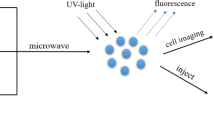Abstract
Cancer is one of the diseases with the highest mortality rate worldwide. Recent studies have shown that different types of nanoparticles, such as carbon dots (CDs), are promising candidates in applications against cancer due to their physical-chemical properties. Moreover, CDs have a high load capacity to integrate with heteroatoms or drugs through do** and functionalization. Here we report the synthesis and characterization of undoped CDs (uCDs) and boron-doped CDs (B-CDs). They were synthesized in a one-step, microwave-assisted reaction at 200 ℃, using citric acid as the carbon source, and four different amino acids were evaluated as nitrogen precursors. Additionally, boric acid was used as the boron precursor for synthesizing B-CDs, obtaining nanoparticles that exhibit green-yellow fluorescence. MTT assay showed that both, uCDs and B-CDs are biocompatible exhibiting viability rates of over 80% after 24 h in HT29, 3T3-L1, U87, and VERO cell lines. The obtained results represent an excellent opportunity to apply these developed B-CDs as cancer theranostic nanoagents and bioimaging probes. In particular, its boron content as a dopant makes them a promising alternative for boron neutron capture therapy (BCNT).
Access this chapter
Tax calculation will be finalised at checkout
Purchases are for personal use only
Similar content being viewed by others
References
I. A. for R. on C. (IARC): Global Cancer Observatory (GCO), 2020 (2021). https://gco.iarc.fr/today/online-analysis-table
Hamilton, W., Walter, F.M., Rubin, G., Neal, R.D.: Improving early diagnosis of symptomatic cancer. Nat. Rev. Clin. Oncol. 13(12), 740–749 (2016). https://doi.org/10.1038/nrclinonc.2016.109
Citrin, D.E.: Recent developments in radiotherapy. N. Engl. J. Med. 377(11), 1065–1075 (2017). https://doi.org/10.1056/NEJMra1608986
Siegel, R.L., Miller, K.D., Fuchs, H.E., Jemal, A.: Cancer statistics, 2021. CA Cancer J. Clin. 71(1), 7–33 (2021). https://doi.org/10.3322/caac.21654
McNamara, K., Tofail, S.A.M.: Nanoparticles in biomedical applications. Adv. Phys. X 2(1), 54–88 (2017). https://doi.org/10.1080/23746149.2016.1254570
Jia, Q., et al.: Recent advances and prospects of carbon dots in cancer nanotheranostics. Mater. Chem. Front. 4(2), 449–471 (2020). https://doi.org/10.1039/C9QM00667B
Liu, M.: Optical properties of carbon dots: a review. Nanoarchitectonics 1(1), 1–12 (2020). https://doi.org/10.37256/nat.112020124.1-12
Yang, S.-T., et al.: Carbon dots for optical imaging in vivo. J. Am. Chem. Soc. 131(32), 11308–11309 (2009)
Song, Y., Zhu, S., Yang, B.: Bioimaging based on fluorescent carbon dots. RSC Adv. 4(52), 27184 (2014). https://doi.org/10.1039/c3ra47994c
Tao, H., et al.: In vivo NIR fluorescence imaging, biodistribution, and toxicology of photoluminescent carbon dots produced from carbon nanotubes and graphite. Small 8(2), 281–290 (2012)
Jiao, M., et al.: Gadolinium doped red-emissive carbon dots as targeted theranostic agents for fluorescence and MR imaging guided cancer phototherapy. Chem. Eng. J. 440, 135965 (2022). https://doi.org/10.1016/j.cej.2022.135965
Chaudhary, S., Umar, A., Bhasin, K.K., Singh, S.: Applications of carbon dots in nanomedicine. J. Biomed. Nanotechnol. 13(6), 591–637 (2017)
Bregadze, V.I., Sivaev, I.B., Glazun, S.A.: Polyhedral boron compounds as potential diagnostic and therapeutic antitumor agents. Anticancer Agents Med Chem. 6(2), 75–109 (2006). https://doi.org/10.2174/187152006776119180
Ali, F., Hosmane, N.S., Zhu, Y.: Boron chemistry for medical applications. Molecules 25(4), 828 (2020). https://doi.org/10.3390/molecules25040828
IAEA: Current Status of Neutron Capture Therapy, pp. 75–77. IAEA (2001)
Manioudakis, J., et al.: Effects of nitrogen-do** on the photophysical properties of carbon dots. J. Mater. Chem. C 7(4), 853–862 (2019). https://doi.org/10.1039/c8tc04821e
Ju, B., et al.: Full-colour carbon dots: integration of multiple emission centres into single particles. Nanoscale 9(35), 13326–13333 (2017). https://doi.org/10.1039/C7NR04576J
Dhenadhayalan, N., Lin, K.-C., Suresh, R., Ramamurthy, P.: Unravelling the multiple emissive states in citric-acid-derived carbon dots. J. Phys. Chem. C 120(2), 1252–1261 (2016). https://doi.org/10.1021/acs.jpcc.5b08516
Lu, F., et al.: Hydroxyl functionalized carbon dots with strong radical scavenging ability promote cell proliferation. Mater. Res. Express 6(6), 065030 (2019). https://doi.org/10.1088/2053-1591/ab0c55
Xu, Y., et al.: Carbon dots as a potential therapeutic agent for the treatment of cancer-related anemia. Adv. Mater. 34(19), 2200905 (2022). https://doi.org/10.1002/adma.202200905
Acknowledgment
D.C.R.B and A.O.M thank Universidad del Rosario for financial support.
S.A.B.S, M.D.S.F, and P.A.W.C acknowledge financial support from MinCiencias under Convocatoria 874 – Jovenes Talento.
Author information
Authors and Affiliations
Corresponding author
Editor information
Editors and Affiliations
Ethics declarations
Conflict of Interest
There are no conflicts to declare.
Rights and permissions
Copyright information
© 2024 The Author(s), under exclusive license to Springer Nature Switzerland AG
About this paper
Cite this paper
Barragan Sicua, S.A., Soto Florido, M.D., Wilches-Castellanos, P.A., Ondo-Méndez, A., Rodríguez Burbano, D.C. (2024). Development of Green-Yellow Fluorescent Boron-Doped Carbon Dots as a Base Structure for Future Construction of Potential Cancer Theranostic Nanoplatform. In: Marques, J.L.B., Rodrigues, C.R., Suzuki, D.O.H., Marino Neto, J., García Ojeda, R. (eds) IX Latin American Congress on Biomedical Engineering and XXVIII Brazilian Congress on Biomedical Engineering. CLAIB CBEB 2022 2022. IFMBE Proceedings, vol 100. Springer, Cham. https://doi.org/10.1007/978-3-031-49407-9_50
Download citation
DOI: https://doi.org/10.1007/978-3-031-49407-9_50
Published:
Publisher Name: Springer, Cham
Print ISBN: 978-3-031-49406-2
Online ISBN: 978-3-031-49407-9
eBook Packages: EngineeringEngineering (R0)




